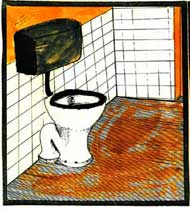|
||||
|
||||
|
|
||||
| Service providers are often unable or unwilling to provide services to the low-income community for several reasons such as the illegal status, the lack of tenure, the risk of losing the investment, problems with payment and others. Often options used for providing the service have often been too prescriptive, relying on standards not applicable or achievable in these circumstances or limited in choice due to historical practices used in medium- and high-income areas.
Utilities lack knowledge of the specific characteristics of low income communities and may also not have the incentive or freedom to be innovative. As a result the gap in the provision of services to the poor has been filled by a variety of mechanisms. The informal sector and NGOs have proliferated to fill the gap. Water delivered from unauthorised connections, handcart and tanker deliveries door to door, domestic vending and new small systems managed by community groups are all part of the creative scenario found in low income communities. Often these efforts are illegal resulting in minimal investment in quality and higher unit cost. Many professional organisations have a resistance to lowering standards whilst what is being demanded is not necessarily a lowering of standards but a change of standards to reflect other desirable outcomes. There are several factors that affect the appropriateness of water and sanitation solutions. The informal nature of settlements with a lack of title to land and thus limited security for investments made, limits the willingness of the utility to invest in household connections. Affordability and therefore viability of services is markedly affected by the payment systems adopted as well as the technology level. Willingness to accept sewerage or septic tanks as sanitation options depends as much, if not more, on the availability of water to operate the system than the affordability. Disposal of wastewater is a problem seldom adequately addressed and the dislocation between agencies responsible for water, sewerage and sanitation systems makes coordinated planning for the low income areas a rare occurrence. As part of their coping strategies communities have resorted to supporting the activities of informal service providers and the development of private sources such as wells. Demanding the closure of private wells on spurious health grounds whilst providing an inadequate formal service with questionable water quality shows a preoccupation with regulation rather than a resolve to address the real service needs of the low income communities. Many service options are available and could be adapted to satisfy almost every situation given the commitment of the regulators and service providers to meet the needs and demands of their customers. Sanitation services have particularly been neglected in low-income communities and possibly because sanitation is viewed as a household responsibility there is no institutionalised delivery. Sewerage is often viewed as inappropriate for low income areas partly because of the water supply problems but also because of low household connection rates, high costs to the consumer and the utility. Community sanitation facilities are often poorly managed with unclear institutional responsibilities. Emptying and disposal arrangements for septic tank and pit latrine waste are difficult to manage or control, sometimes due to restrictive regulations and a lack of competition. The weak links between water/ sewerage/ sanitation authorities make satisfactory solutions harder to reach and reduce the opportunity for joint billing, cross subsidy and coordinated management. |
||||
Recommended actions:
|
||||
|
||||


